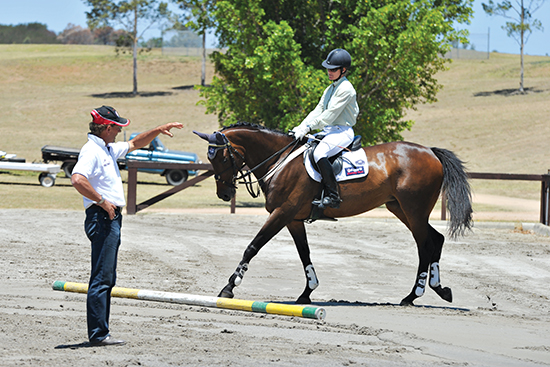 Working with Wendy Schaeffer
Working with Wendy Schaeffer
Story by Chris Hector and photos by Roz Neave & archives
One of Jamie’s star pupils is Wendy Schaeffer. In the lead up to the World Cup final qualifier at the ISS Classic, Wendy based her mare Koyuna Sunset at Jamie’s and then Jamie flew up to Sydney to work the pair in…
But it was a warm up unlike any warm up, you’ve seen before. Walk, more walk, and more walk again. Even walk over some little jumps, but as Jamie explains, he felt the situation needed more cooling down than heating up:
“ I did a lot of walk to start with to chill Wendy and her mare out. We’ve really worked on the idea that we don’t want them over-jumping and just getting the job done. I want a more professional picture, a steadier horse, a more educated horse that is trained so it can be ridden over the more technical tracks at 375-400 metres a minute.”
“We’ve got away with it for the past two seasons but now we have to attack it, and make it a better picture, we want to be very professional and classical in the job we do. With Wendy, you have to really slow her down, she is a very busy person in her mind… so I always start with a lot of walking with her, just chilling her out.”
“Then we work on getting the softness, bending lines, curving lines, holding the lines. She sometimes rides showjumps like she rides cross country – cross country you just have to get from A to B and not necessarily classically ridden on a curve. Sometimes Wendy goes a little too direct, or a little too wide and square, she has to learn just as we walk them on a curve, she has to ride them on a curve. You need that curve to get them under themselves, over the back, the inside hind leg is good… top course builders build lines the way they want you to ride them. Watch the course builder walk the course, and they walk curving lines not right angles.”
“Leopoldo Palacios, the course designer at the ISS show in Sydney, did a wonderful job, he got our riders riding again. We get caught out here with time faults and he got our riders freed up again and you see the better horses, the more educated horses, have no problems with his courses.”
“At that ISS show, you could see the improvement with Wendy’s horse on the flat, that’s been a big break through. The mare has been difficult, she is not a patient mare but she is starting to know her job really well, she is becoming very mature in herself and we are making a big break through on the flat. There is a lot of trust involved in this process because with the work we are doing on the flat we are getting her a lot softer, so we are losing the over-jumping she had in the past, so Wendy is feeling maybe she hasn’t got as much jump in the horse, but give it another three or four months, when the mare trusts that she can travel soft and steady, she’ll be able to produce the very best jump that she can do and what we have seen her do. We want to take the frantic ride out of her.”
You feel that when you are training a horse sometimes you have to come back a little on your way to a higher level?
“You will, because you focus on one area and you want that area to become better, you will lose something else for a little while, but you’ve just got to trust that eventually it will come together and the whole thing will work better than ever. You’ve got to put away the doubts, and believe that what you are doing will get you to the end you are aiming for.”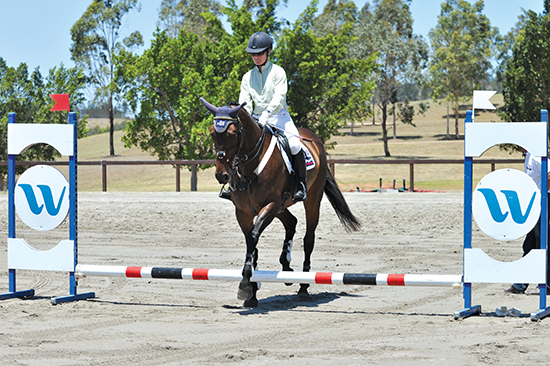
After you’d done your walking work with Wendy, what did you do in the warm up?
“We started to work on the curving lines, cantering over the poles, nothing too big because the mare had had two starts already at that show, and the temperature was high – we didn’t want to do too much. It’s all about keeping Wendy at a level in her mind, very relaxed and focused. You allow her to ride the horse in the warm up because she feels she has to ride something, but you have to police how much she does and what she does, because we need enough horse for those big tracks. Our result in the class was three down. Two because we have been changing our ways, and Wendy got there a little too quiet and soft, and maybe she didn’t ride her turns well enough, which resulted in one time fault… the last fence, she just allowed herself to get a little pushy and over-ride to the last. But she has made such a big dramatic step in what she is doing – she will take a little step back for a while, but then the end result will be great, she’ll come back and be a really good showjumping rider.”
You’ve worked with most of our top eventing riders, is it different working with established elite athletes, it’s not the fresh faced kid from down the road turning up for lessons…
“It is – I have been very fortunate to be able to work with pretty well every elite rider in this country, it’s an honor that they trust you to be able to help them and they believe in what you are doing. To work with a total professional, it’s easier but harder because you have to be always thinking, you’ve got to be very focused for them because they’ve got their job, and they rely on you, they want you to support them and help them ride a track, and be there to make sure the warm up is perfect or as good as we can make it.”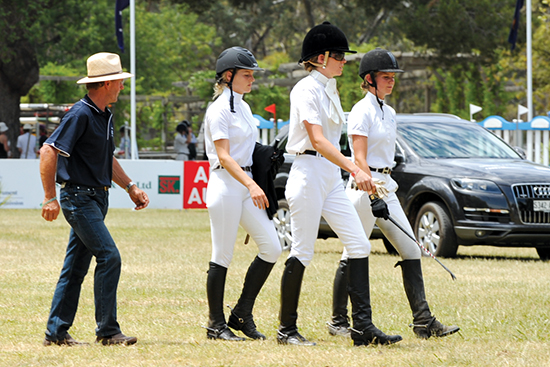
Do eventers all have the same sorts of difficulties with the showjumping phase?
“They do I suppose. In our training during the week, we are working with a horse with energy but by the last day of an event, when I get my chance to work them in, it’s a different horse. That’s why I have been going to quite a lot of these big events, so I can see the horses on that last day. I try to make sure they become very correct in their riding, I don’t allow them to warm up too much. We change the frame of the horse, we take it from the dressage arena, from the rectangle to the oval. I do a lot of training of courses with them, we do a lot of jumping different lines, riding inside turns.”
“When we are working with the horses on the final day of an event, they are jumping from memory of what we did during the week. When we start our warm ups for the eventers on the last day, we go back to the exercises we did during the week to get the horse to log in to, this is your program for today: we are showjumping. We are not cross country, so you have to change your ways. You’re to travel not as quick, but still in a good shape, and the riders have to get on the program too, they’ve got to get their eye back from jumping cross country where they need to be open and bold to closing up and getting deeper and up into the air again. It’s been great working with the eventers because it really makes you think, how do you get this horse prepared? With a lot of the eventers we do very little jumping on the last morning before the showjumping. We do a lot of walking, poles, just small exercises that we’ve done during the week, to remind them, that’s what we want – it’s time to showjump today.”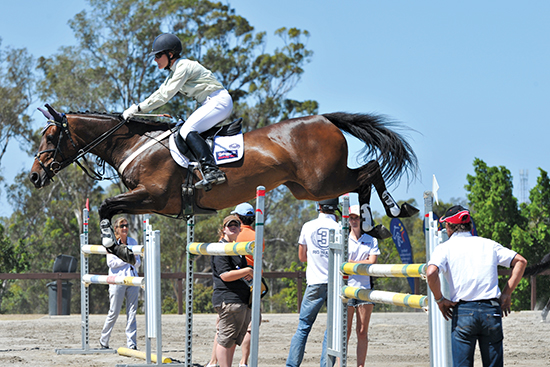
Wendy Schaeffer – working with Jamie Coman…
“The most important thing about working with Jamie is that attention to detail. It’s just re-iterating basic principles – it’s got to be rounder, deeper, more collection, it’s getting to that next level I suppose. It’s really stressing what you already know, but reminding you that you have to be better. Have the reins a bit shorter, she needs to be rounder, no you actually need your reins here, and hold your fingers here, so you have a real connection with the hand. There is nothing startling, or out of left field, it is just attention to detail, being much more pedantic about getting it right.”
Jamie says that he thought it required quite a lot of trust from you, because in slightly remaking the mare – softer, looser – that you were losing some of that extravagant jump that comes out of tension…
“Or just a result of her being a bit wild… I think it is more a matter of me being confident to get the same sort of jump but give her a more classical ride but that then involves me having the confidence not to have so much in my hand. I guess that is what went wrong a little bit at the ISS show, and I didn’t quite have enough canter, particularly in the first round. I watched the video afterwards, and she didn’t do a whole lot wrong, touched three fences behind, it wasn’t the disaster that it felt like at the time. It’s just a matter of being able to ride that connection a bit better, doing in the ring what we do in training.”
Jamie says that one of his major jobs is slowing you down – he had you walking over little rails… is it hard to do that when your instinct is to go jump, jump, jump?
“I’m much more relaxed about doing that sort of thing, and I really understand the value of getting her tuned over the really little fences. It’s much better to have a bump over a tiny pole than scare her over a big fence. I’m relatively cool when I am in Jamie’s hands in a warm up situation prior to the class, it’s really good before a big class to have the responsibility taken out of your hands.”
I guess you first started working with Jamie with your eventers…
“Yes, it would have been about August 05, when he was the National Showjumping Coach, and he helped the eventers.”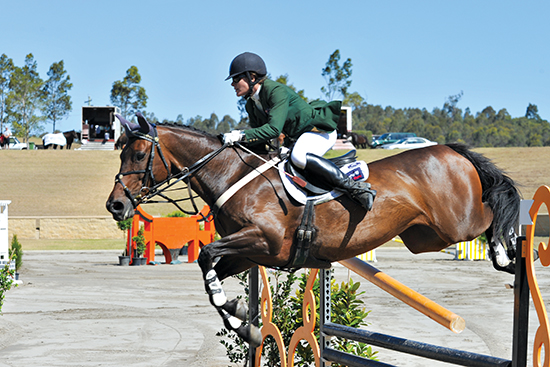
Does he work differently with the eventers?
“No, no, basically it is all about training them to be classical jumpers – at the time I was riding Magic who was jumping B grade, and Megan was riding Jester, we were jumping bigger fences than the state showjumping squad was.”
Has that been part of your success, that you have combined your eventing with your showjumping… when the Kiwis were great they always did that?
“I suppose so, it just trains you to be a better jumping rider. If you are only jumping cross country and event sized showjumping, that is limiting how much you progress the horse as a jump horse – so showjumping has really got its place. I’ve perhaps done a little too much showjumping in the past twelve months, and maybe I haven’t done enough with the event horses, not even enough schooling on the arena on those really tight lines of corners and turns. I got a little caught out in Adelaide. We’d been doing really well in our jump classes but perhaps I didn’t have the steering I needed there – we certainly hadn’t practiced any angles as severe as those ducks! But then, Dancer jumped them great, so who knows? I guess the more jumping you do, the better you get and perfect practice makes perfect… eventers need jumping but they also need dressage as well, it’s a balance between the three phases.”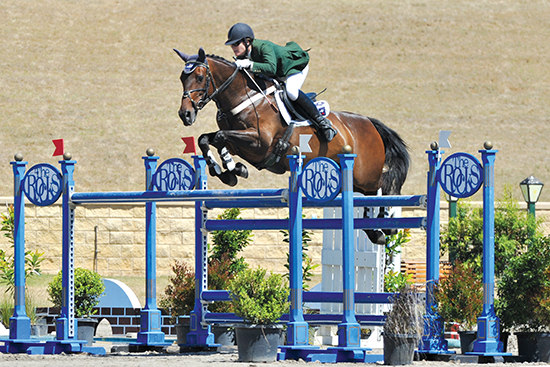
So have you made the big decision yet – are you going to try for the WEG Eventing Team or the Showjumping Team?
“I’ll basically do what I have to and try to make the decision as late as I can. Ultimately, and it is a bit manic and crazy, but I’d like to do both. Obviously it would be a bit difficult, but technically it is possible. At the WEG, the first week is eventing and the second week is showjumping… I’ll just see. At this stage the plan is to do the showjumping selection trials on the mare, in New Zealand, in March, and the Sydney Royal – then do the eventing selection trials at Sydney and Werribee with the event horses. After that I will have a better idea of where I stand… but who knows? Anything can happen so quickly!”
Jamie goes to the Games…
Jamie’s biggest competition moment came on the SIEC arena, representing his country at the 2000 Olympic Games, and the horse he rode was an Australian Thoroughred, JJ Zazu bred at the well-known Shipton Lodge, owned by Bruce McHugh.
Jamie recalls the horse with affection: “He was bred in the purple but he didn’t even look like a Thoroughbred. He couldn’t run at all, he was so slow. I think they tried to get one barrier trial out of him and then gave up, which was great because it kept his legs really good. He was a late three year old when I got him. He rode so beautifully right from the start, snaffle mouthed – and you knew he couldn’t run away from you because he was so slow. He was so nicely trained you could pretty well do a Prix St Georges test on him – he was such a naturally balanced horse.”
“I was very lucky that Roy Davis, who showed the McHugh Show horses, had ridden him, and Roy said he’s not very pretty looking, but he is a beautiful ride. I guess if he’d been pretty I would never have seen him, Roy would have kept him for the Show Ring.”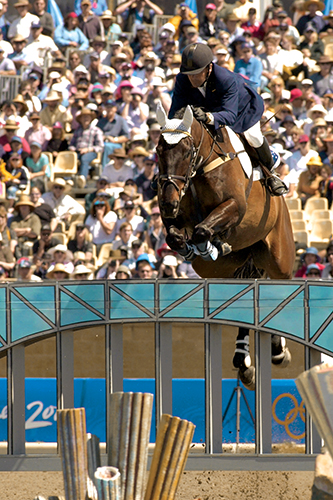
“When we took him home we thought, we better try this horse but I couldn’t get him to go anywhere near a pole! I had to lead him to get him over a pole. Anything that was new – he was very very careful. Once he calmed down, we gave him a little free jump and he looked okay… but I think that ‘spook’ goes with a top horse, you need them to have that, they’ve got to be bright, at the end of the day that will get you carefulness. At the start it can be a pain because they spook and look into things and knock jumps down. Once they get over that, they are very aware.”
“We first took him out jumping early in his four year old year. He rode so well, and he hadn’t raced, so he had a very good mind, but we took him quite slowly that first year. At the first show we took him to, we jumped him in the Maiden D Grade, and he broke three rails. Not because he cantered through them, he just tried to jump too high and landed on the back rail of oxers – he just wanted to get up in the air so high that he forgot he had to jump out as well. We just did a few more classes and then rested him.”
“As a late four year old, five year old, he won every D grade Championship he went to, then he won all his C grade Championships through to B grade. He became a very very good horse. “
“He had half a season of Mini-Prix and we stepped him up to his first World Cup, he had three fences down but he jumped very well. That was back in 1998, just two years before he went to the Games. We didn’t do a lot of shows with him, he was just such a good horse.”
“It was amazing to ride on to the arena at the Sydney Games. All I ever wanted to do is the right thing by my horse and give it the best ride I could, but to ride out there, last horse to go on the first day… we’d been waiting all day, and it was so hard, feeling that special atmosphere, and to ride in knowing that a lot of people had stayed just to watch me ride. I felt I really had a job to do. And he did it, he really performed that day… he was wonderful, wonderful. It was the best feeling ever – that, and having our daughter, Hayley.”
“After the Games, we wanted to take him to Europe, we had a COC out of the Games, so we took him to a World Cup at Penrith, to get another qualifier, and he won it by 16… 20 faults! He had six months rest after that, chilling out, he was only a nine year old and he needed the break. We brought him back in for Melbourne Royal, then Tonimbuk… I’d got a call from Hank Noren in Holland, asking if I wanted to take him over and train with him, and ride some of his horses as well.”
“It was a great opportunity, so I said, yes we will go. We knew then, yeah, one day the horse will be sold, whether it be then, or after the 2002 WEG. We put the horse into quarantine, and I went across and we started our campaign leading up to the World’s, the following year. But then came the opportunity to sell the horse – we had partners in him that we had to look after, and we decided to sell him. It was a good home, a Brazilian family bought him, so he was sold, and that was pretty much the end of my international riding career.”
“That still hurts… Once it seemed so easy to find a good horse, now it has become so hard to find that horse. I don’t know if we’ve become more fussy, we’re more educated in our riding and we don’t accept the way some horses go – horses that could be very good horses.”
“Now we are breeding these beautiful purpose bred horses, and perhaps we have to change our ways. They can jump, we have to change our ways, to have a plan, and be patient. With the Thoroughbred, you could just go, you expected it to be hot, so you rode it hot – but with the purpose bred horses, they are a lot colder, they’ve got enough blood about them but it is different blood, it’s not a tense, sensitive blood, it’s an energy in the purpose bred ones. We need to learn patience and it doesn’t matter if they turn six or seven or even eight, before they are ready to be out there.”
“Every day you train or ride, you think, I would love to go back there… to go to a Games, to take a team to a Worlds, it’s another world you go to – the adrenalin is amazing, I love it. It’s the greatest feeling you can ever have.”
This article first appeared in the March 2010 issue of THM.
For more training articles with Jamie, go to:


